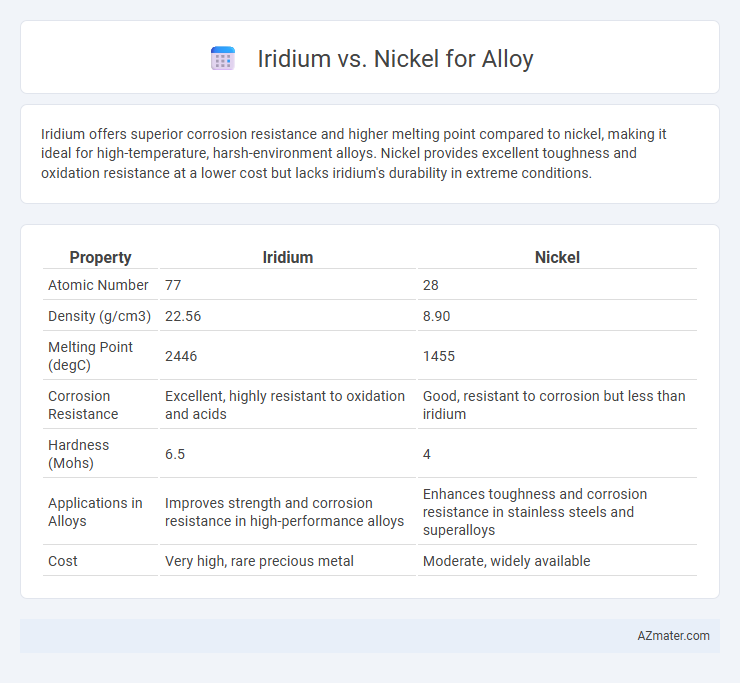Iridium offers superior corrosion resistance and higher melting point compared to nickel, making it ideal for high-temperature, harsh-environment alloys. Nickel provides excellent toughness and oxidation resistance at a lower cost but lacks iridium's durability in extreme conditions.
Table of Comparison
| Property | Iridium | Nickel |
|---|---|---|
| Atomic Number | 77 | 28 |
| Density (g/cm3) | 22.56 | 8.90 |
| Melting Point (degC) | 2446 | 1455 |
| Corrosion Resistance | Excellent, highly resistant to oxidation and acids | Good, resistant to corrosion but less than iridium |
| Hardness (Mohs) | 6.5 | 4 |
| Applications in Alloys | Improves strength and corrosion resistance in high-performance alloys | Enhances toughness and corrosion resistance in stainless steels and superalloys |
| Cost | Very high, rare precious metal | Moderate, widely available |
Introduction to Iridium and Nickel Alloys
Iridium alloys are renowned for exceptional corrosion resistance, high melting points above 2446degC, and outstanding mechanical strength, making them ideal for extreme environments like aerospace and chemical processing. Nickel alloys feature excellent oxidation resistance, versatility in composition, and superior toughness, widely used in power generation, marine applications, and industrial machinery. Both Iridium and Nickel alloys offer unique benefits, with Iridium excelling in durability under harsh conditions and Nickel providing cost-effective, versatile solutions for high-temperature applications.
Chemical and Physical Properties Comparison
Iridium exhibits exceptional corrosion resistance and a melting point of 2466degC, surpassing nickel's 1455degC, making it ideal for high-temperature alloy applications. Chemically, iridium is highly inert, resisting oxidation and acids, whereas nickel shows moderate reactivity and forms surface oxides. Physically, iridium is denser (22.56 g/cm3) and harder to machine compared to nickel's lighter density (8.90 g/cm3) and greater ductility, influencing alloy strength and workability.
Mechanical Strength and Durability
Iridium alloys exhibit exceptional mechanical strength and durability due to their high melting point around 2446degC and remarkable resistance to corrosion and wear, making them ideal for extreme environments. Nickel alloys offer substantial mechanical strength with excellent toughness and resistance to oxidation, particularly at elevated temperatures, but generally have lower hardness compared to iridium alloys. The superior hardness and corrosion resistance of iridium alloys contribute to their enhanced durability in demanding industrial applications compared to nickel-based alloys.
Corrosion and Oxidation Resistance
Iridium exhibits superior corrosion and oxidation resistance compared to nickel, making it ideal for extreme environments and high-temperature applications. While nickel offers moderate resistance to oxidation, it tends to form surface oxides that can degrade over time under harsh conditions. Iridium's exceptional chemical inertness and high melting point ensure prolonged durability and stability, especially in aggressive chemical environments.
Thermal Stability and Conductivity
Iridium exhibits superior thermal stability compared to nickel, maintaining structural integrity at temperatures exceeding 2400degC, while nickel alloys typically degrade above 1400degC. Iridium's thermal conductivity is lower than nickel's, with values around 147 W/m*K versus nickel's approximately 90 W/m*K, but its exceptional resistance to oxidation at high temperatures makes it ideal for extreme thermal environments. Nickel alloys offer better electrical and thermal conductivity under moderate conditions, making them suitable for applications requiring efficient heat transfer but less extreme thermal endurance.
Cost and Availability of Iridium vs Nickel
Iridium is significantly more expensive than nickel due to its rarity and limited availability, being one of the rarest elements in the Earth's crust with a price often exceeding thousands of dollars per ounce. Nickel is abundant and widely mined globally, making it far more cost-effective and accessible for large-scale alloy production. The high cost and scarce supply of iridium restrict its use to specialized, high-performance alloys, whereas nickel is preferred for common industrial applications due to its affordability and availability.
Applications in Industry and Technology
Iridium alloys are prized in the aerospace and electronics industries for their exceptional corrosion resistance and high melting points, making them ideal for spark plugs, crucibles, and thermocouples. Nickel alloys dominate in chemical processing, power generation, and marine applications due to their superior strength, oxidation resistance, and excellent performance in extreme environments. Combining these metals harnesses iridium's durability and nickel's versatility, enhancing efficiency and longevity in high-stress technological components.
Environmental Impact and Sustainability
Iridium alloys exhibit superior corrosion resistance and longer lifespan, reducing the need for frequent replacement and minimizing environmental waste compared to nickel-based alloys. Nickel production is associated with significant ecological concerns, including habitat destruction and high energy consumption, whereas iridium's rarity and recyclability contribute to its sustainable profile despite higher extraction challenges. Prioritizing iridium in alloy production supports sustainability efforts by lowering environmental footprint through enhanced durability and efficient recycling processes.
Alloying Behavior and Compatibility
Iridium exhibits excellent corrosion resistance and high melting point, making it compatible with platinum and rhodium in high-performance alloys, especially in aerospace and catalytic applications. Nickel offers superior ductility and oxidation resistance, allowing it to form stable solid solutions with elements like chromium and iron, enhancing mechanical strength and thermal stability. When alloyed, iridium improves hardness and high-temperature stability, while nickel provides toughness and corrosion resistance, with careful control required to balance their differing atomic sizes and phase compatibility.
Choosing the Right Metal: Iridium or Nickel?
Iridium offers exceptional corrosion resistance and high melting points making it ideal for extreme environments where durability is crucial while nickel provides excellent oxidation resistance and is more cost-effective for large-scale applications requiring moderate strength. The choice between iridium and nickel depends on the specific alloy's performance requirements including temperature tolerance, wear resistance, and budget constraints. For aerospace and medical devices, iridium alloys excel due to their superior strength and stability whereas nickel alloys are preferred in automotive and industrial applications for their versatility and economic advantages.

Infographic: Iridium vs Nickel for Alloy
 azmater.com
azmater.com